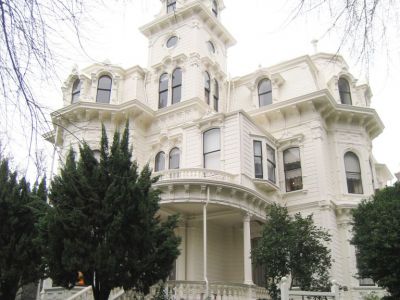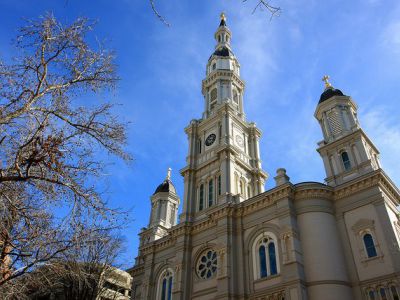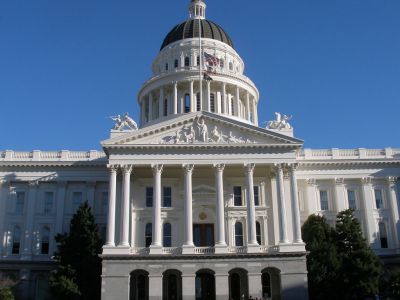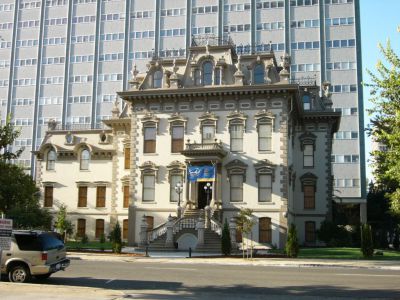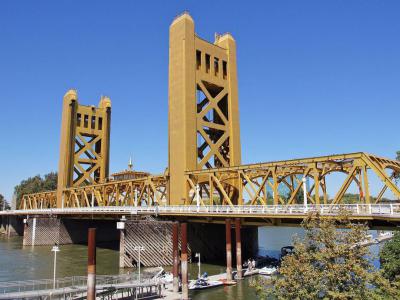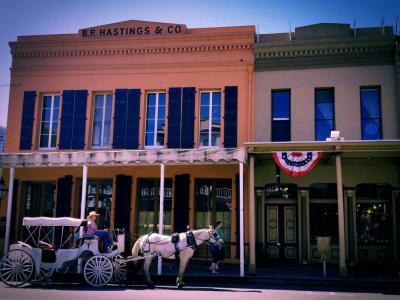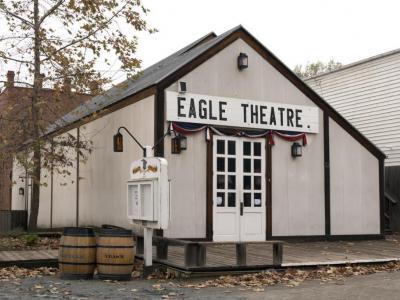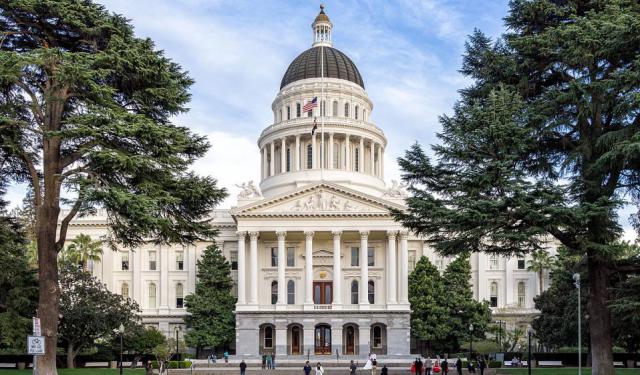Historical Buildings Walking Tour (Self Guided), Sacramento
The Gold Rush of the mid-1800s brought a large number of gold miners and prospects to Sacramento. The city expanded further when the California State Legislature moved here in 1854. Some of Sacramento’s historic buildings date back to that period and used to accommodate the flood of gold seekers and growing government business.
The elegant Governor's Mansion State Historic Park once served as the official residence of California's governors, from 1903 to 1967. Its opulent interior and lush gardens offer visitors a taste of the early 20th-century California high society.
The Sacramento Masonic Temple has been a center for Masonic activities in town since its construction in 1918. Its grand facade attests to the Masonic fraternity's significance in the city's history.
The Cathedral of the Blessed Sacrament is a fine example of Renaissance Revival architecture and has been a spiritual cornerstone of Sacramento since its dedication in 1889.
The historic heart of California's government, the California State Capitol Museum, has witnessed key legislative decisions since its completion in 1874. It's not just a symbol of governance but also a repository of the state's history and culture.
Leland Stanford Mansion State Historic Park: This beautifully restored mansion was once home to the former governor and founder of Stanford University. It offers a glimpse into the opulent lifestyle of the state's early elite.
The iconic Tower Bridge, connecting Sacramento and West Sacramento, is recognizable by its distinctive Streamline Moderne design and vertical lift span that make it a symbol of the city's progress and unity.
The Pony Express Terminal, formerly a crucial stop for the Pony Express riders, harkens back to the days of the Wild West. It's a living relic of the city's frontier history.
Finally, the Eagle Theatre, a historic treasure for theater enthusiasts, dates back to the Gold Rush era – a hub for entertainment and culture in the mid-19th century.
These historical buildings not only preserve the city's heritage but also offer visitors a chance to step back in time and appreciate the stories that have shaped Sacramento. If you're a history buff or simply curious about the past, these landmarks are waiting for your exploration. Visit them, learn their stories, and connect to Sacramento's eventful history. Your journey through time begins here!
The elegant Governor's Mansion State Historic Park once served as the official residence of California's governors, from 1903 to 1967. Its opulent interior and lush gardens offer visitors a taste of the early 20th-century California high society.
The Sacramento Masonic Temple has been a center for Masonic activities in town since its construction in 1918. Its grand facade attests to the Masonic fraternity's significance in the city's history.
The Cathedral of the Blessed Sacrament is a fine example of Renaissance Revival architecture and has been a spiritual cornerstone of Sacramento since its dedication in 1889.
The historic heart of California's government, the California State Capitol Museum, has witnessed key legislative decisions since its completion in 1874. It's not just a symbol of governance but also a repository of the state's history and culture.
Leland Stanford Mansion State Historic Park: This beautifully restored mansion was once home to the former governor and founder of Stanford University. It offers a glimpse into the opulent lifestyle of the state's early elite.
The iconic Tower Bridge, connecting Sacramento and West Sacramento, is recognizable by its distinctive Streamline Moderne design and vertical lift span that make it a symbol of the city's progress and unity.
The Pony Express Terminal, formerly a crucial stop for the Pony Express riders, harkens back to the days of the Wild West. It's a living relic of the city's frontier history.
Finally, the Eagle Theatre, a historic treasure for theater enthusiasts, dates back to the Gold Rush era – a hub for entertainment and culture in the mid-19th century.
These historical buildings not only preserve the city's heritage but also offer visitors a chance to step back in time and appreciate the stories that have shaped Sacramento. If you're a history buff or simply curious about the past, these landmarks are waiting for your exploration. Visit them, learn their stories, and connect to Sacramento's eventful history. Your journey through time begins here!
How it works: Download the app "GPSmyCity: Walks in 1K+ Cities" from Apple App Store or Google Play Store to your mobile phone or tablet. The app turns your mobile device into a personal tour guide and its built-in GPS navigation functions guide you from one tour stop to next. The app works offline, so no data plan is needed when traveling abroad.
Historical Buildings Walking Tour Map
Guide Name: Historical Buildings Walking Tour
Guide Location: USA » Sacramento (See other walking tours in Sacramento)
Guide Type: Self-guided Walking Tour (Sightseeing)
# of Attractions: 8
Tour Duration: 2 Hour(s)
Travel Distance: 3.5 Km or 2.2 Miles
Author: Dee
Sight(s) Featured in This Guide:
Guide Location: USA » Sacramento (See other walking tours in Sacramento)
Guide Type: Self-guided Walking Tour (Sightseeing)
# of Attractions: 8
Tour Duration: 2 Hour(s)
Travel Distance: 3.5 Km or 2.2 Miles
Author: Dee
Sight(s) Featured in This Guide:
- Governor's Mansion State Historic Park
- The Sacramento Masonic Temple
- Cathedral of the Blessed Sacrament
- California State Capitol Museum
- Leland Stanford Mansion State Historic Park
- Tower Bridge
- Pony Express Terminal
- Eagle Theatre
1) Governor's Mansion State Historic Park
The Governor's Mansion State Historic Park in Sacramento is a significant site that showcases both California’s political and architectural heritage. The park is built around the former residence of the California governor, used from 1903 to 1967 and again from 2015 to 2019. The mansion itself was constructed in 1877 and features a blend of Second Empire and Italianate styles, typical of the lavish tastes of that time.
The mansion was originally built for Albert Gallatin, a local businessman, and changed ownership in 1887 to Joseph Steffens, whose son, Lincoln Steffens, became a famous journalist. The state bought the property in 1903 to use as the official governor's residence. It was home to 14 governors until Ronald Reagan decided against living there in 1967, after which the mansion was managed by California State Parks and turned into a historic park.
Inside, the mansion holds a collection of cultural items from various governors, like a Steinway piano from 1902 during Governor George Pardee’s time, velvet furniture from Governor Hiram Johnson’s days, and Persian rugs from Earl Warren’s tenure. Each piece reflects the personal style and historical period of the governors and their families.
The mansion was temporarily used again as the governor's residence after extensive renovations in 2015 when Governor Jerry Brown moved in. These renovations updated essential services and improved safety features, including the removal of lead paint and the installation of a fire sprinkler system. Governor Gavin Newsom lived there briefly until 2019.
Now, the Governor's Mansion State Historic Park functions as a museum open to the public. Visitors can tour the well-preserved rooms with their original furnishings and decorations that tell the story of California's gubernatorial eras. The park’s grounds are also historic, with diverse plants and trees dating back to when the mansion was built, adding to its historical value. The park offers visitors a unique view of the state’s gubernatorial past and its architectural development.
The mansion was originally built for Albert Gallatin, a local businessman, and changed ownership in 1887 to Joseph Steffens, whose son, Lincoln Steffens, became a famous journalist. The state bought the property in 1903 to use as the official governor's residence. It was home to 14 governors until Ronald Reagan decided against living there in 1967, after which the mansion was managed by California State Parks and turned into a historic park.
Inside, the mansion holds a collection of cultural items from various governors, like a Steinway piano from 1902 during Governor George Pardee’s time, velvet furniture from Governor Hiram Johnson’s days, and Persian rugs from Earl Warren’s tenure. Each piece reflects the personal style and historical period of the governors and their families.
The mansion was temporarily used again as the governor's residence after extensive renovations in 2015 when Governor Jerry Brown moved in. These renovations updated essential services and improved safety features, including the removal of lead paint and the installation of a fire sprinkler system. Governor Gavin Newsom lived there briefly until 2019.
Now, the Governor's Mansion State Historic Park functions as a museum open to the public. Visitors can tour the well-preserved rooms with their original furnishings and decorations that tell the story of California's gubernatorial eras. The park’s grounds are also historic, with diverse plants and trees dating back to when the mansion was built, adding to its historical value. The park offers visitors a unique view of the state’s gubernatorial past and its architectural development.
2) The Sacramento Masonic Temple
The Sacramento Masonic Temple, located on J Street in downtown Sacramento, is a historic landmark that embodies the architectural splendor and cultural heritage of the early 20th century. Constructed between 1913 and 1918, this five-story structure was designed by Rudolph Herold, a prominent local architect known for his significant contributions to the city's architectural landscape. The building was added to the National Register of Historic Places in 2001, recognizing its historical and architectural significance.
The Masonic Temple stands out with its impressive facade, featuring face brick and patterned terra cotta on its south and east elevations, under a hipped roof parapet covered with clay mission tiles. Its design incorporates shallow terra cotta-sheathed fluted pilasters that vertically divide the facade into bays, creating a visually striking aesthetic. The building's principal elevations on 12th Street and J Street feature eight and five bays respectively, enhancing its grandeur.
The interior of the building is just as remarkable. It boasts an 8,000-square-foot room capable of hosting up to 499 guests for sit-down events. This versatile space has been utilized for a myriad of events, from weddings and family celebrations to conferences and product launches, making the temple a central hub for community activities in Sacramento.
The Sacramento Masonic Temple remains one of the most intact architectural period pieces in downtown Sacramento, continuing to serve as a testament to the city's rich historical and architectural heritage. Its enduring beauty and functional adaptability have cemented its status as a cherished landmark in the Sacramento community.
The Masonic Temple stands out with its impressive facade, featuring face brick and patterned terra cotta on its south and east elevations, under a hipped roof parapet covered with clay mission tiles. Its design incorporates shallow terra cotta-sheathed fluted pilasters that vertically divide the facade into bays, creating a visually striking aesthetic. The building's principal elevations on 12th Street and J Street feature eight and five bays respectively, enhancing its grandeur.
The interior of the building is just as remarkable. It boasts an 8,000-square-foot room capable of hosting up to 499 guests for sit-down events. This versatile space has been utilized for a myriad of events, from weddings and family celebrations to conferences and product launches, making the temple a central hub for community activities in Sacramento.
The Sacramento Masonic Temple remains one of the most intact architectural period pieces in downtown Sacramento, continuing to serve as a testament to the city's rich historical and architectural heritage. Its enduring beauty and functional adaptability have cemented its status as a cherished landmark in the Sacramento community.
3) Cathedral of the Blessed Sacrament
The Cathedral of the Blessed Sacrament in Sacramento serves as the mother church of the Roman Catholic Diocese of Sacramento and holds the seat of Jaime Soto, the ordinary bishop of the diocese. It is strategically located downtown at the intersection of 11th and K Streets.
With its roots tracing back to 1887 when its construction began, the cathedral showcases a blend of architectural brilliance and historical significance. The design was inspired by the Church of the Holy Trinity (L'Eglise de la Sainte-Trinite) in Paris, as envisioned by Sacramento's first bishop, Patrick Manogue, who aimed to recreate the grandeur of European churches he admired. On completion, it became the largest cathedral west of the Mississippi River, boasting dimensions of approximately 200 feet in length and 100 feet in width, with seating capacity for 1,400 people. Its central bell tower, reaching a height of 215 feet, adds to its majestic appearance.
Architecturally, the cathedral presents an Italian Renaissance exterior and a Victorian interior, reflecting a harmonious blend of styles. Despite modern updates to accommodate contemporary use, efforts have been made to maintain the original stylistic elements. Over the years, the cathedral has undergone various changes including repairs and updates to its color schemes and liturgy, which have slightly altered its stylistic unity.
The Cathedral of the Blessed Sacrament not only serves as a place of worship but also as a historical landmark in Sacramento. It is part of a diocese that extends from the southern edge of Sacramento County to the Oregon border, encompassing 99 churches over a region of 42,000 square miles, serving about 975,000 Catholics. The cathedral’s significance as both a religious and civic landmark underlines its importance in the community it serves.
With its roots tracing back to 1887 when its construction began, the cathedral showcases a blend of architectural brilliance and historical significance. The design was inspired by the Church of the Holy Trinity (L'Eglise de la Sainte-Trinite) in Paris, as envisioned by Sacramento's first bishop, Patrick Manogue, who aimed to recreate the grandeur of European churches he admired. On completion, it became the largest cathedral west of the Mississippi River, boasting dimensions of approximately 200 feet in length and 100 feet in width, with seating capacity for 1,400 people. Its central bell tower, reaching a height of 215 feet, adds to its majestic appearance.
Architecturally, the cathedral presents an Italian Renaissance exterior and a Victorian interior, reflecting a harmonious blend of styles. Despite modern updates to accommodate contemporary use, efforts have been made to maintain the original stylistic elements. Over the years, the cathedral has undergone various changes including repairs and updates to its color schemes and liturgy, which have slightly altered its stylistic unity.
The Cathedral of the Blessed Sacrament not only serves as a place of worship but also as a historical landmark in Sacramento. It is part of a diocese that extends from the southern edge of Sacramento County to the Oregon border, encompassing 99 churches over a region of 42,000 square miles, serving about 975,000 Catholics. The cathedral’s significance as both a religious and civic landmark underlines its importance in the community it serves.
4) California State Capitol Museum (must see)
The capitol building houses the working bicameral state legislature and governor's offices. It was built in 1874, designed to be reminiscent of the US Capitol in Washington DC. The Senate chamber's red decorations refer to the British House of Lords, while the green tones in the Assembly chamber come from their House of Commons.
The basement and first floor of the state capitol building are dedicated as a museum. The tour office is located on the basement level, along with a small theater and gift shop. The first floor consists of several historic offices that have been restored, including those of the Secretary of State, Governor, and Treasurer. There are also rotating exhibits that highlight the history of the state. Forty acres of gardens surround the building, with over 200 types of trees and 155 memorials. The park takes up the space of ten city blocks.
Why You Should Visit:
Besides seeing state governance's operating seat, the capitol also houses an extensive art collection that features hundreds of paintings, statues, murals, and antiques. Items displayed in the West Wing are from 1870 to 1910, known as the interpretive period. The East Annex features art from 1920 to 1950. There are also two noteworthy murals depicting historical events, one in the lower rotunda and one in the East Annex. Throughout the West Wing, you will see portraits of California's 38 governors.
The grounds of the building are worth strolling around. You'll see numerous monuments throughout Capitol Park, dedicated to important events and people from the state's history. Notable are the Camellia Grove, dedicated to the pioneers who settled the state and a gathering place in honor of California Indians.
Tips:
During weekends, you must enter the museum through the N Street entrance. Free public tours depart hourly from 9 am to 4 pm from the tour office located on the basement level seven days a week.
If you're in town during the early spring, check out Camellia Day. More than 800 varieties of the plant grow in Capitol Park, with showy and colorful white, red, pink, and striped flowers.
The basement and first floor of the state capitol building are dedicated as a museum. The tour office is located on the basement level, along with a small theater and gift shop. The first floor consists of several historic offices that have been restored, including those of the Secretary of State, Governor, and Treasurer. There are also rotating exhibits that highlight the history of the state. Forty acres of gardens surround the building, with over 200 types of trees and 155 memorials. The park takes up the space of ten city blocks.
Why You Should Visit:
Besides seeing state governance's operating seat, the capitol also houses an extensive art collection that features hundreds of paintings, statues, murals, and antiques. Items displayed in the West Wing are from 1870 to 1910, known as the interpretive period. The East Annex features art from 1920 to 1950. There are also two noteworthy murals depicting historical events, one in the lower rotunda and one in the East Annex. Throughout the West Wing, you will see portraits of California's 38 governors.
The grounds of the building are worth strolling around. You'll see numerous monuments throughout Capitol Park, dedicated to important events and people from the state's history. Notable are the Camellia Grove, dedicated to the pioneers who settled the state and a gathering place in honor of California Indians.
Tips:
During weekends, you must enter the museum through the N Street entrance. Free public tours depart hourly from 9 am to 4 pm from the tour office located on the basement level seven days a week.
If you're in town during the early spring, check out Camellia Day. More than 800 varieties of the plant grow in Capitol Park, with showy and colorful white, red, pink, and striped flowers.
5) Leland Stanford Mansion State Historic Park (must see)
Completed in 1857 and purchased a few years later by Leland Standford, this four-story house covers over 19,000 square feet. Standford was the co-founder and president of the Central Pacific Railroad, California's eighth governor, and Stanford University founder. The house has been under the care and management of the state parks since 1998. It is still used for official functions by the governor's and legislative offices and is kept open for public tours.
The original owner of the house was local merchant Shelton C. Fogus. He had the home constructed in a distinctive Renaissance Revival architecture style. In 1861, just before he was elected governor, Stanford purchased the home for $8,000. He used the mansion as his executive office and home. The next two governors did the same. Stanford expanded and modified the home greatly to suit his needs and have it raised above flood level.
The home was donated to the Roman Catholic Diocese by Jane Stanford after her husband and son's deaths. It was used as an orphanage for decades before becoming restored to its present showpiece condition.
The mansion was designated a California historic landmark and a National Historic Landmark.
Tips:
Keep in mind that the daily tours of the mansion can be affected by the official functions and events held there. Before heading over, be sure to double-check that tours are available on your planned day.
Enter through the visitor's center on the back of the property. Free guided tours depart hourly from there.
The original owner of the house was local merchant Shelton C. Fogus. He had the home constructed in a distinctive Renaissance Revival architecture style. In 1861, just before he was elected governor, Stanford purchased the home for $8,000. He used the mansion as his executive office and home. The next two governors did the same. Stanford expanded and modified the home greatly to suit his needs and have it raised above flood level.
The home was donated to the Roman Catholic Diocese by Jane Stanford after her husband and son's deaths. It was used as an orphanage for decades before becoming restored to its present showpiece condition.
The mansion was designated a California historic landmark and a National Historic Landmark.
Tips:
Keep in mind that the daily tours of the mansion can be affected by the official functions and events held there. Before heading over, be sure to double-check that tours are available on your planned day.
Enter through the visitor's center on the back of the property. Free guided tours depart hourly from there.
6) Tower Bridge
Coming into the city via US Highway 40, it's hard to miss the eye-catching and dramatic Tower Bridge. The vertical lift bridge was opened for traffic in 1935. It replaced the original M Street Bridge, which at only 25 years old was already causing concerns with traffic congestion. The possibility of war and the need for moving supplies from west to east across the US was a significant factor in building the bridge. The original design featured two single-land roadways on either side of central railroad tracks, but the train tracks were removed in the early 1960s.
The 209-foot long lift section of the bridge weighs around five million pounds. Still, the clever use of perfectly balanced counterweights means that two relatively small electric motors can operate the bridge. When the bridge is up, it provides 100 feet of vertical clearance for vessels sailing up the Sacramento River. The towers are 160 feet tall and extend 50 feet below the water surface and into the river bed to provide structural support for the bridge's colossal weight.
The bridge's paint scheme has been changed several times over the years. The present gold color, applied in 2002, was chosen by a local vote.
The 209-foot long lift section of the bridge weighs around five million pounds. Still, the clever use of perfectly balanced counterweights means that two relatively small electric motors can operate the bridge. When the bridge is up, it provides 100 feet of vertical clearance for vessels sailing up the Sacramento River. The towers are 160 feet tall and extend 50 feet below the water surface and into the river bed to provide structural support for the bridge's colossal weight.
The bridge's paint scheme has been changed several times over the years. The present gold color, applied in 2002, was chosen by a local vote.
7) Pony Express Terminal
The Pony Express Terminal, historically known as the B. F. Hastings Bank Building, is a significant landmark located on 2nd Street in Sacramento. Constructed in 1852, this two-story brick building served as the westernmost point of the Pony Express during its brief operation from 1860 to 1861. Recognized for its historical importance, it was designated a National Historic Landmark in 1966.
Architecturally, the building features a utilitarian design with a facade that displays four bays facing J Street and nine bays along 2nd Street. A distinctive feature is the single-story canopy that stretches across the sidewalk in front of both facades, upheld by simple square posts. A metal staircase centrally positioned on the 2nd Street side provides access to a second-floor entrance.
Today, the building houses a museum dedicated to the history of Wells Fargo in Sacramento. Visitors can explore a recreated 19th-century Wells Fargo Express Company office, complete with artifacts from the company's history and the California Gold Rush era. The museum also offers exhibits detailing Wells Fargo's involvement in the commerce of the Gold Rush period. This site, along with the Wells Fargo History Museum located in the Wells Fargo Center, provides a comprehensive view of the company's historical significance in the region.
Architecturally, the building features a utilitarian design with a facade that displays four bays facing J Street and nine bays along 2nd Street. A distinctive feature is the single-story canopy that stretches across the sidewalk in front of both facades, upheld by simple square posts. A metal staircase centrally positioned on the 2nd Street side provides access to a second-floor entrance.
Today, the building houses a museum dedicated to the history of Wells Fargo in Sacramento. Visitors can explore a recreated 19th-century Wells Fargo Express Company office, complete with artifacts from the company's history and the California Gold Rush era. The museum also offers exhibits detailing Wells Fargo's involvement in the commerce of the Gold Rush period. This site, along with the Wells Fargo History Museum located in the Wells Fargo Center, provides a comprehensive view of the company's historical significance in the region.
8) Eagle Theatre
The Eagle Theatre holds a special place in the history of California as the first permanent theater built in the state. Located on Front Street in Sacramento, this theater was established in 1849 during the height of the Gold Rush, an era that saw rapid population growth due to the influx of miners and pioneers.
Constructed from wood framing and canvas with a tin roof, the Eagle Theatre was originally a modest structure. Its earth floor and simple design mirrored the makeshift, emergent character of Sacramento at the time. Unfortunately, the theater's tenure as an entertainment venue was short-lived, as it was destroyed by flooding on January 4, 1850, only a few months after its opening.
Despite its brief initial operation, the Eagle Theatre played a significant role in the cultural life of early Sacramento. It provided a venue for various forms of entertainment, catering to the robust and diverse crowd of Gold Rush miners. Tickets for performances were sold at the nearby Round Tent Saloon, indicating the close relationship between local businesses and entertainment at the time.
In recognition of its historical importance, a replica of the Eagle Theatre was built in 1974 within the Old Sacramento State Historic Park. This replica seeks to stay as true as possible to the original, although with some modern adjustments for safety and preservation. For example, the original beaten earth floor was replaced with asphalt, and the seating capacity was reduced to accommodate only 150 people, ensuring a safer and more comfortable experience for visitors.
Today, the Eagle Theatre is managed by the California Department of Parks and Recreation and falls under the administration of the California State Railroad Museum. It continues to serve as a significant landmark within the Old Sacramento State Historic Park, offering visitors a glimpse into the vibrant cultural history of early California and its pioneering days.
Constructed from wood framing and canvas with a tin roof, the Eagle Theatre was originally a modest structure. Its earth floor and simple design mirrored the makeshift, emergent character of Sacramento at the time. Unfortunately, the theater's tenure as an entertainment venue was short-lived, as it was destroyed by flooding on January 4, 1850, only a few months after its opening.
Despite its brief initial operation, the Eagle Theatre played a significant role in the cultural life of early Sacramento. It provided a venue for various forms of entertainment, catering to the robust and diverse crowd of Gold Rush miners. Tickets for performances were sold at the nearby Round Tent Saloon, indicating the close relationship between local businesses and entertainment at the time.
In recognition of its historical importance, a replica of the Eagle Theatre was built in 1974 within the Old Sacramento State Historic Park. This replica seeks to stay as true as possible to the original, although with some modern adjustments for safety and preservation. For example, the original beaten earth floor was replaced with asphalt, and the seating capacity was reduced to accommodate only 150 people, ensuring a safer and more comfortable experience for visitors.
Today, the Eagle Theatre is managed by the California Department of Parks and Recreation and falls under the administration of the California State Railroad Museum. It continues to serve as a significant landmark within the Old Sacramento State Historic Park, offering visitors a glimpse into the vibrant cultural history of early California and its pioneering days.
Walking Tours in Sacramento, California
Create Your Own Walk in Sacramento
Creating your own self-guided walk in Sacramento is easy and fun. Choose the city attractions that you want to see and a walk route map will be created just for you. You can even set your hotel as the start point of the walk.
Sacramento Introduction Walking Tour
Though little evidence is left now, the Sacramento Valley was home to the Modoc, Plains Miwok, and Nisenan Native American tribes for thousands of years before the arrival of the pioneers and the Spanish. John Sutter Sr. settled at the confluence of the American and Sacramento Rivers, land bequeathed to him by the Mexican government in 1839. He had his eyes on creating an agriculture empire. You... view more
Tour Duration: 2 Hour(s)
Travel Distance: 4.2 Km or 2.6 Miles
Tour Duration: 2 Hour(s)
Travel Distance: 4.2 Km or 2.6 Miles
The Most Popular Cities
/ view all



